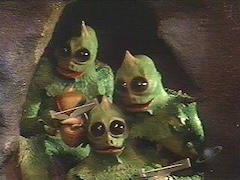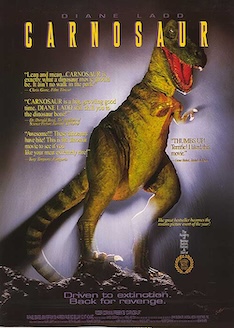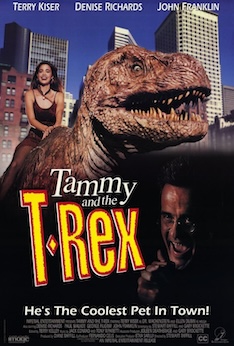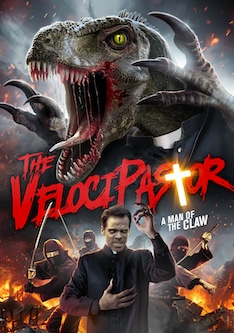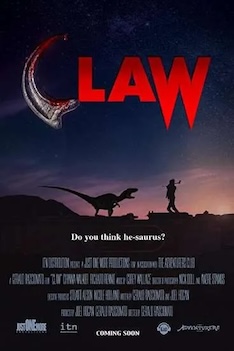Terrible Lizards
The Terror Tourist is my occasional segment on the Heavy Leather Horror Show, a weekly podcast about all things horror out of Salem, Massachusetts. These segments are also available as an email newsletter. Sign up here, if interested.
Tourists, our journey today takes us to a place but also to a time — approximately 66 million years ago. We’re headed to a day, actually — the most horrifying and deadly single day in the history of life on our planet. Grab your snacks and lots of water. If you have a Kevlar body suit, pack that too. OK let’s go!
We are off the coast of Mexico, just to the northwest of a small fishing village called Chicxulub on the Yucatán peninsula. It is the end of the Age of Reptiles. Humans do not exist yet and won’t for 65 million years or so.
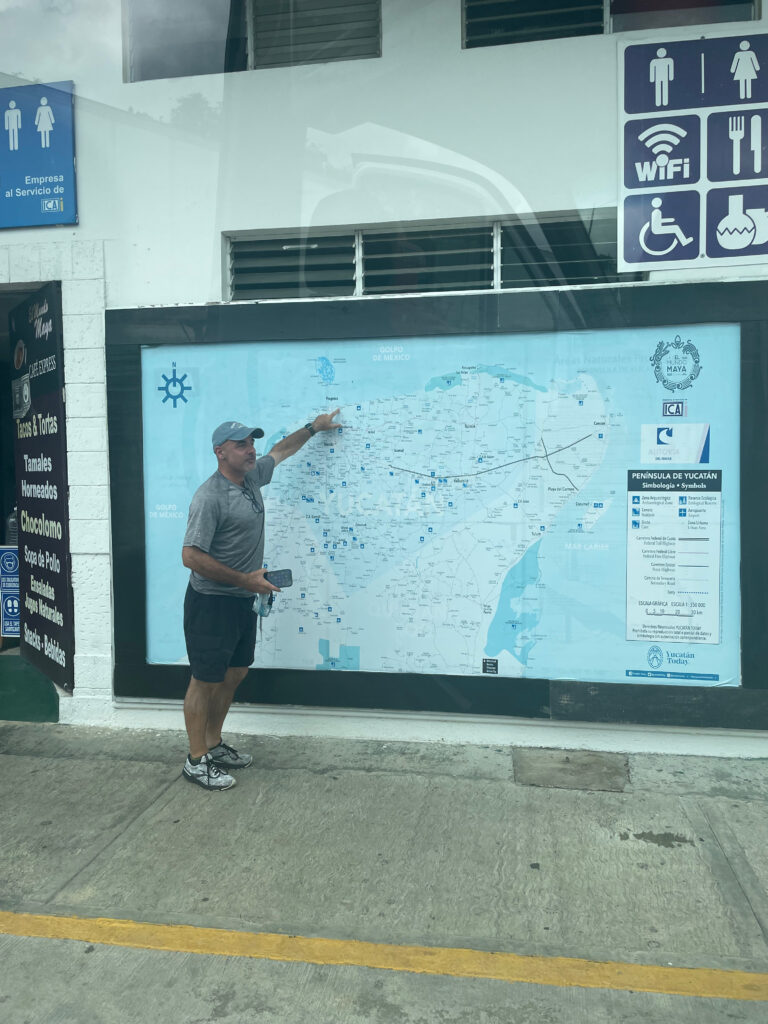
Dinosaurs dominate every continent of Earth and have for several hundred million years. Some of the most popular dinosaurs in our current public imagination are here now — T. Rex, Triceratops, Ankylosaurs (the armored ones), Pachycelphalosaurs (the one with the giant ramming dome on its head), and Velociraptors. They are all around us, whether we see them or not; they see us.
We look up and a light appears in the northeast sky. It’s becoming larger and larger by the minute. It’s a meteor — a chunk of the early solar system that just happens to be on a collision course with Earth. Meteors had collided with earth before and will again, but this time the chunk is large (more than 6 miles across) and fast (traveling at about 12 miles per second). In the blink of an eye the meteor slams into the shallow ocean with the energy of 72 trillion tons of dynamite.
All horror, fictional or real, pales in comparison to what comes next.
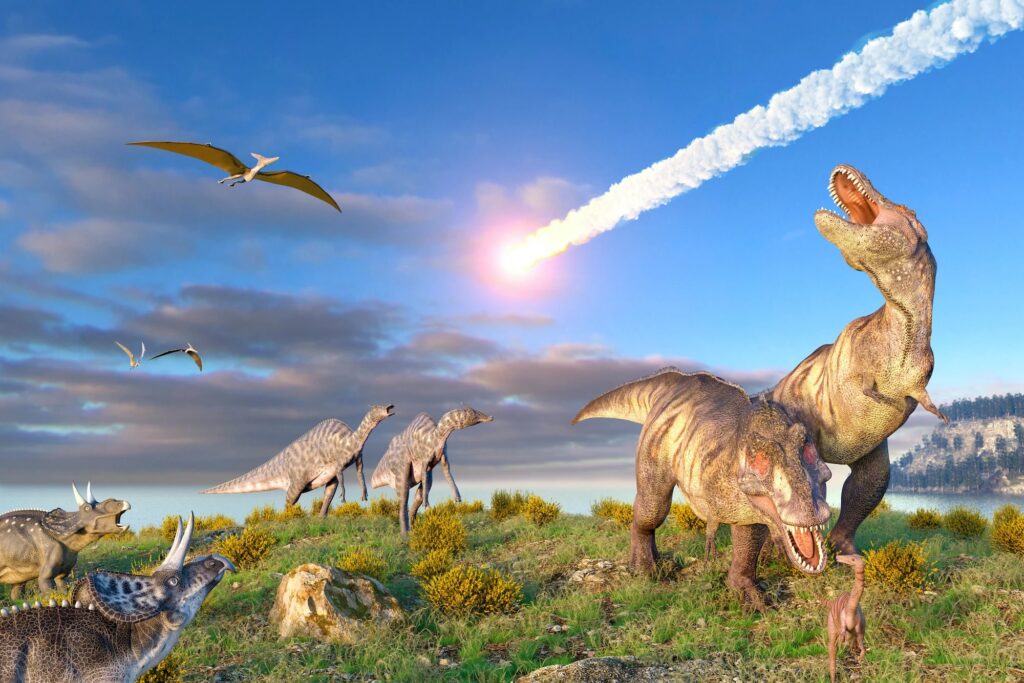
Everything within 100 miles of the impact is instantly vaporized. Life anywhere within 1000 miles of the impact zone is destroyed only slightly less quickly by 620 mph winds, 330’ tall mega-tsunamis, and earthquakes whose magnitude would not even register on our current Richter scale. Dinosaurs here are the lucky dead.
The impact ejects 25 trillion tons of sea floor into the atmosphere. Hot dust, ash, steam, and rock are tossed so high that some achieve escape velocity and scatter throughout the solar system (giving rise to the not entirely implausible theory that there could be dinosaur fossils or even mummified body parts on the moon). But most of that 25 trillion tons of junk falls back to earth, heating to molten temperatures on re-entry. And this is where the real hell on earth begins.
The infrared radiation and heat generated by all this returning material cooks the air globally (our planet’s rotation spreading the heat evenly like a giant earth-sized rotisserie). The air itself is on fire. Basically if you are a living creature and you can not burrow deep into the earth or dive deep underwater you are incinerated by the scorching air. And let’s face it, most dinosaurs are large and not adapted for digging or submersion. Wildfires ignite — only further raising ambient temperatures. This happens all in the course of the first day, nearly everywhere on earth.
Some life survived, obviously, or we wouldn’t be here as tourists. But even most of the initial survivors would eventually perish. All the smoke from those fires only adds to the carbon-rich gunk that is now lodged in the high atmosphere, creating a years-long “impact winter” that basically blots out the sun permanently. Photosynthesis stops so plant life ceases. Without any food herbivorous creatures die. Then any carnivores which eat the herbivores die. In the end 75% of all life on earth is wiped out. A few of our ancestors, tiny burrowing mammals, thankfully make it past this extinction boundary and here were are, ready to talk about dinosaurs in horror movies.
Today’s itinerary is called Terrible Lizards, the literal meaning of the word “dinosaur”.
Dinosaurs are perfect for the big screen in so many ways. They are, of course, some of the largest creatures ever to inhabit the earth. But they also fascinate because of the length of their dominance atop the food chain — and their cataclysmic demise. But most of all apex dinosaur predators are scary. There’s a reason the T. Rex’s arms were so laughably tiny. With a neck so strong and teeth so long the head was all that’s needed to do what a T. Rex does so well: rip its prey apart.
Cinemagenic and terrifying! So obviously there are hundreds of dinosaur-based horror movies, right? I am here to regretfully inform you, fellow travelers, that the answer is no, no there are not. Dinosaur horror, such as it exists, seems to bend toward action-adventure, thrillers and even comedy. There are very few straight-up horror movies involving dinosaurs.
Certainly creature features owe much of their power to our culture’s knowledge and latent fear of dinosaurs. From the Black Lagoon to Godzilla reptilian predators have been a staple of horror and horror-adjacent films for almost a century. But these baddies are almost always not quite dinosaurs. Take the Sleestaks from the television show Land of the Lost: reptilian, sure, but also humanoid and even insectoid with their giant unblinking eyes. Are they scary? This tour guide child of the 80s is here to say: you bet they are. Are they dinosaurs? Not really. The Loch Ness monster — centerpiece of at least one not-great group watch on this show — is, if anything, a plesiosaur. We won’t get into it here, but these large marine reptiles are not dinosaurs, frightful though they are. The Megalodon? Not a dinosaur either.
And yet, dinosaurs have been the subject of filmmaking almost as long as it’s been a medium. From their first depiction in 1905’s Prehistoric Peeps to the seminal model animation of 1925’s The Lost World up through the 1993 blockbuster Jurassic Park, dinosaur films are a massive part of the history of cinema. There’s even a dinosaur museum in the middle-of-nowhere Utah called, uh, The Dinosaur Museum, with a truly impressive permanent exhibition on the history of dinosaurs in film, including a physical recreation of how stop-motion and forced perspective were used to achieve their presence in early film. If you’re ever in Blanding, Utah you should visit.
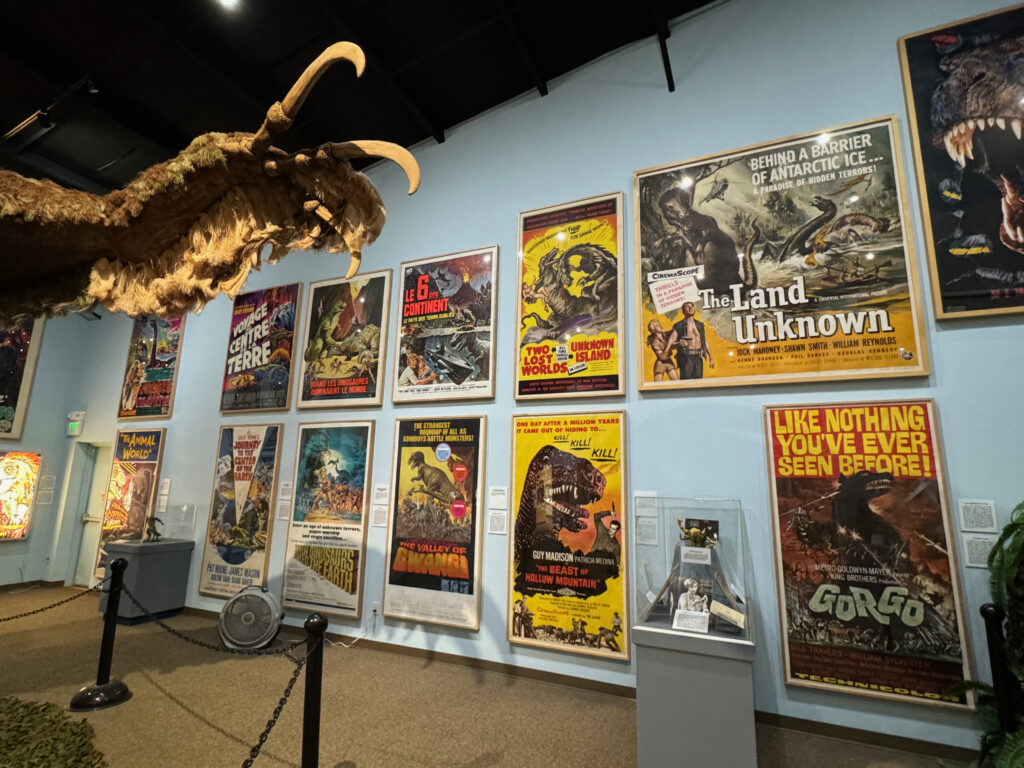
So why so few true horror movies with dinosaurs? I have a few ideas.
- The size and complexity of dinosaurs make them difficult to portray convincingly. Doing so requires ample budget, something our beloved genre often lacks. For much of movie history the technology to portray dinosaurs well simply did not exist widely. Claymation and stop-motion only go so far.
- Dinosaurs are not great villains. Big and reptilian doesn’t automatically mean scary. Many dinosaurs just munched on treetops. Even the Rex and raptor were just doing their thing, looking for prey — like a lion or a wolf. They wanna eat, that’s their motive. Concerning if you’re a delectable human, sure, but not horrifying.
- Related to this is that many people grow up loving dinosaurs. They are a staple of children’s programming. Many people have a favorite dino. Few children have a favorite serial killer or zombie. Those who do grow up and participate in podcasts about like this one.
So, yeah, almost zero horror movies involve dinosaurs. Almost, because there are plenty that attempt it, but they are never played completely straight. Or, the terror is not sustained for the entire film. The original Jurassic Park is a great example. The scenes of running from a rampaging T. Rex or hiding from door-handle-operating Velociraptors is without question frightening. But this is the punctuation rather than the grammar of the film. (It could also be the music.) And we may have Jurassic Park to blame for the relative crap that exists today calling itself dinosaur horror. That movie’s advances in CGI inspired legions of filmmakers to pop dinosaurs into situations that would otherwise have been cost-prohibitive. But without a blockbuster Hollywood budget nearly all these films become laughable the moment the CGIsaurus appears.
Let’s visit a few of these films, my tourist friends.
1993 wasn’t only the year of Jurassic Park. It was also the year of Jurassic Park knock-offs. Enter our man Roger Corman. His film, Carnosaur, was meant to directly compete with and capitalize on the marketing machine behind Spielberg’s film. Roger Ebert called it the worst film of 1993. It’s probably the best dinosaur horror film I have seen. Make of those two statements what you will. Featuring Diane Ladd and a young Clint Howard, Carnosaur’s main plot point is the use of infected chicken eggs, which contain a lethal virus that impregnates women with dinosaur embryos, to exterminate the planet of humans and repopulate it with dinosaurs. There are, alas, almost more chickens in this film than dinosaurs. And being a Corman flick the actual dinosaur effects here are all puppets and animatronics — not horrible for what they are, but still pretty bad. Ironically, Carnosaur gets the science a bit more right than even Jurassic Park. The main baddie is a Deinonychus, a more accurate depiction than Jurassic Park’s Velociraptor which is in actuality is the size of a turkey, partially feathered, and did not hunt in packs, but it has a cooler name. The climatic battle between a T. Rex and a guy operating a front loader is straight out of Aliens. Carnosaur spawned four sequels/knock-offs, almost all using the same models and/or footage from the original because … Roger Corman.
One year later in 1994 we get perhaps the strangest entry in this tiny sub-genre, Tammy and the T-Rex. This film answers the obvious question: what if Frankenstein but with a dinosaur and set in a high school? Featuring Denise Richards and Paul Walker, Tammy and the T-Rex is about a teenager killed by bullies whose brain is then implanted in a robotic Tyrannosaurus rex by a mad scientist. The bullies get their due, naturally, at the disproportionately small hands of this cyborg Tyrannosaur. This is a bizarre movie, but it’s fun and absolutely not something you’ve seen before. In 2019 Vinegar Syndrome restored much of the original, intended gore removed upon release. Find that one for the full experience.
Hands-down the winner for best title in all of dinosaur horror is 2017’s The VelociPastor. You know what you’re in for even just seeing the title in print as the P in “velocipastor” is intercapped uppercase to make absolutely certain you understand the play on words. The VelociPastor is many things, but subtle isn’t one of them. Because none of it makes any sense whatsoever I’ll just lay it all out as a sequence of words: distraught priest being pursued by ninjas finds an enchanted artifact that turns him into a dragon (which is really a dinosaur) who then sets about killing criminals with the assistance of his prostitute sidekick. For what it is, this movie succeeds. And what is it exactly? A $36,000 film that uses an actual discarded high school dinosaur mascot costume for its protagonist. There’s even a scene of a car explosion where no car explodes and a caption reads [insert VFX here]. Sometimes when you have a title this good the movie it’s attached to doesn’t actually matter.
Claw from 2021 seemed promising, as it is built on classic horror tropes. A stand-up comedian and her agent are driving through the American west and have car trouble. They end up stranded in a “ghost town”, one of dozens of tourist attractions that prop up the facades of buildings from a forgotten past. Good start, yeah? They meet the proprietor of the ghost town, a gent named Ray, who also collects dinosaur fossils. Turns out there’s a living raptor on the property as well — we’re never told how or why — and almost the entirety of the remainder of the film is just an extended scene of the protagonists hiding from the beast in and around a camper trailer. But wait, there’s almost a one-year-later epilogue that involves a dream sequence and a T. Rex nowhere near the ghost town. Claw goes to show that the pieces to make real dinosaur horror exist, it just didn’t put them together very well.
I could go on, but you deserve better than all this, my travel buddies. If you need more for some reason, just search any film database for the word “Rex”. Ebola Rex, Poseidon Rex, Anonymous Rex, Theodore Rex. All lizards, all terrible. Dinosaur Prison, The Dinosaur Project, Hatched, Area 407, and last year’s 65 with Adam Driver. Not worth your time or, frankly, worth the legacy of the amazing creatures they depict.
If this is your thing, my recommendation is to go back earlier — discard some of your need for pure horror — and watch more sci-fi entries like Dinosaurus (1960), Valley of the Gwangi (1969), The Land that Time Forgot (1974), or Planet of the Dinosaurs (1977). These aren’t masterpieces but they aren’t parodies either. Best of all: zero bad CGI.
And if you are a filmmaker this is your opportunity. Which one of you will make the first truly great dinosaur horror film? We have the technology and the more science teaches us about dinos the more novel story lines abound. Let me leave you with two ideas, royalty-free:
- For real-world crazy, creationists can’t be beat. Did you know that one of the centerpieces of their belief is that dinosaurs and humans existed side-by-side? There’s even a museum in Texas that purports to show early human footprints next to dinosaur tracks. This is of course complete bullshit, but … what about a horror movie that somehow plops creationists into the world 66 million years ago? They look for fellow humans, find none, are hunted by dinosaurs, and ultimately take a giant meteor to the face. I’d watch that.
- Fossil hunting itself presents plenty of great opportunities for horror. There’s secrecy about and danger all around the dig sites (super hot, dangerously dry, poachers, snakes, bears, etc) and tons of potentially lethal digging and blasting equipment. Someone give me a serial killer paleontologist. Living dinosaurs not even required!
OK everyone, I’ll leave you here. Don’t forget to tip your tour guide. We look forward to seeing you on our next journey.
A full list of the movies mentioned above can be found at Letterboxd. Find out where to watch there.

